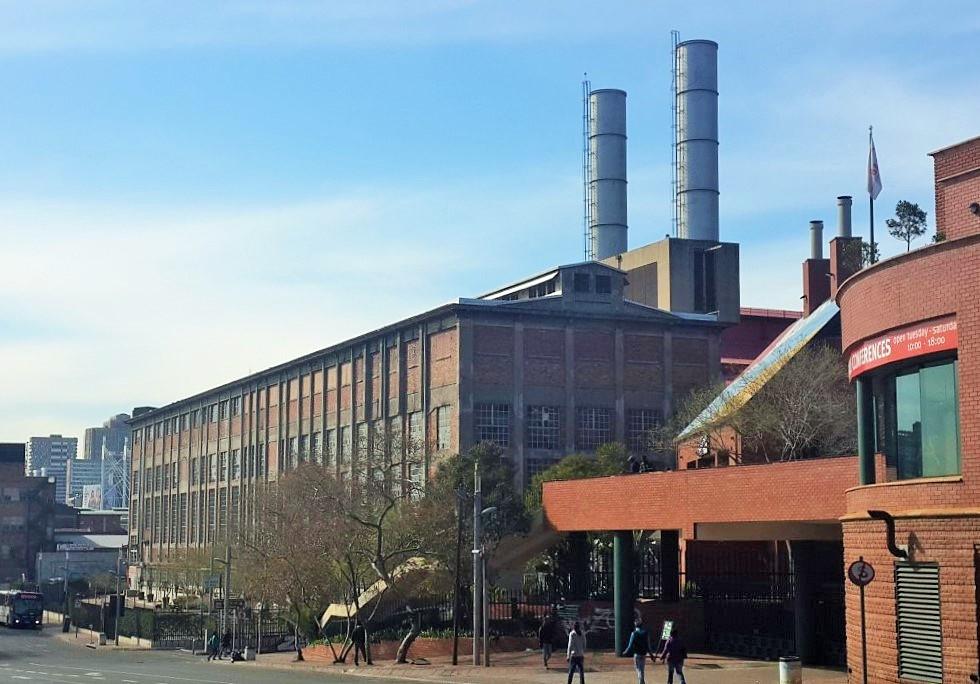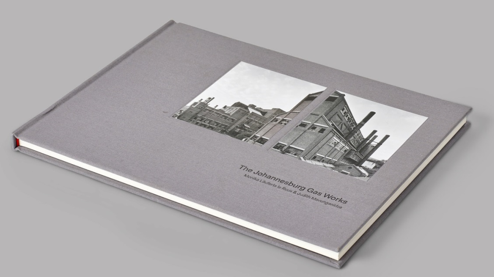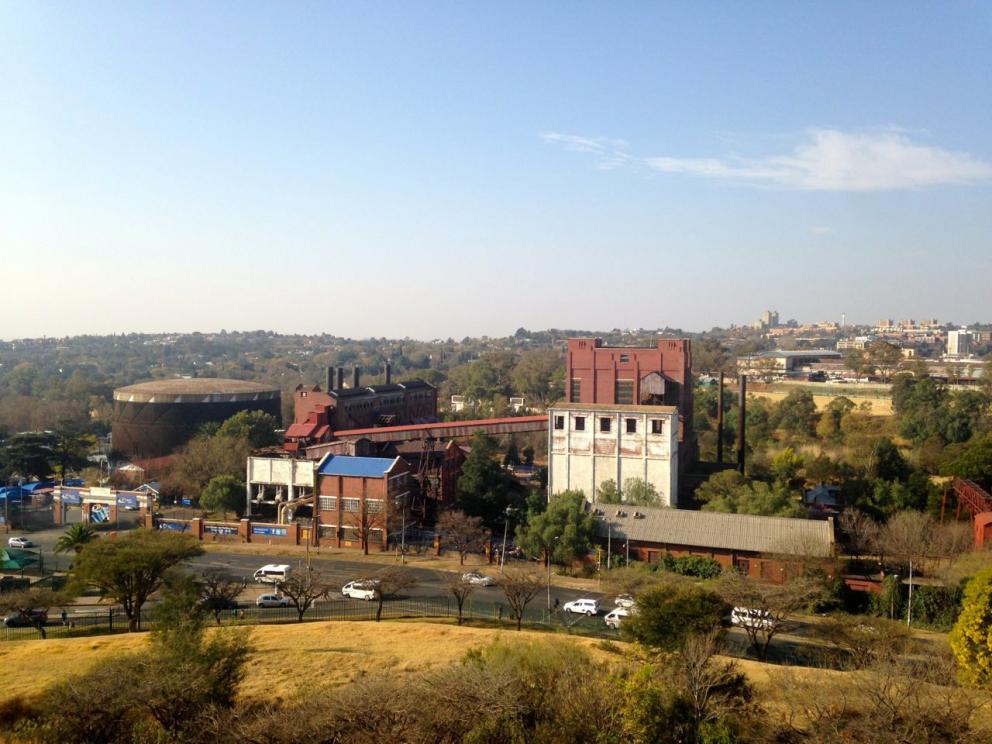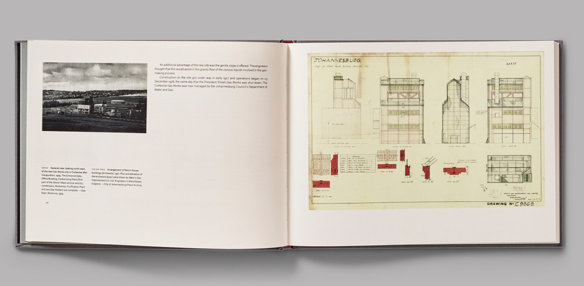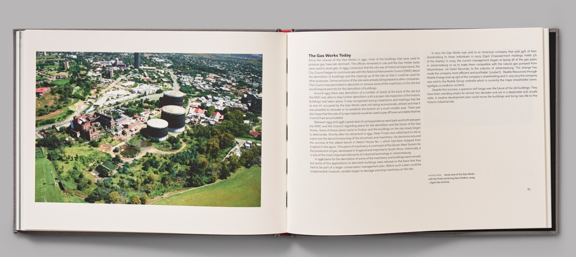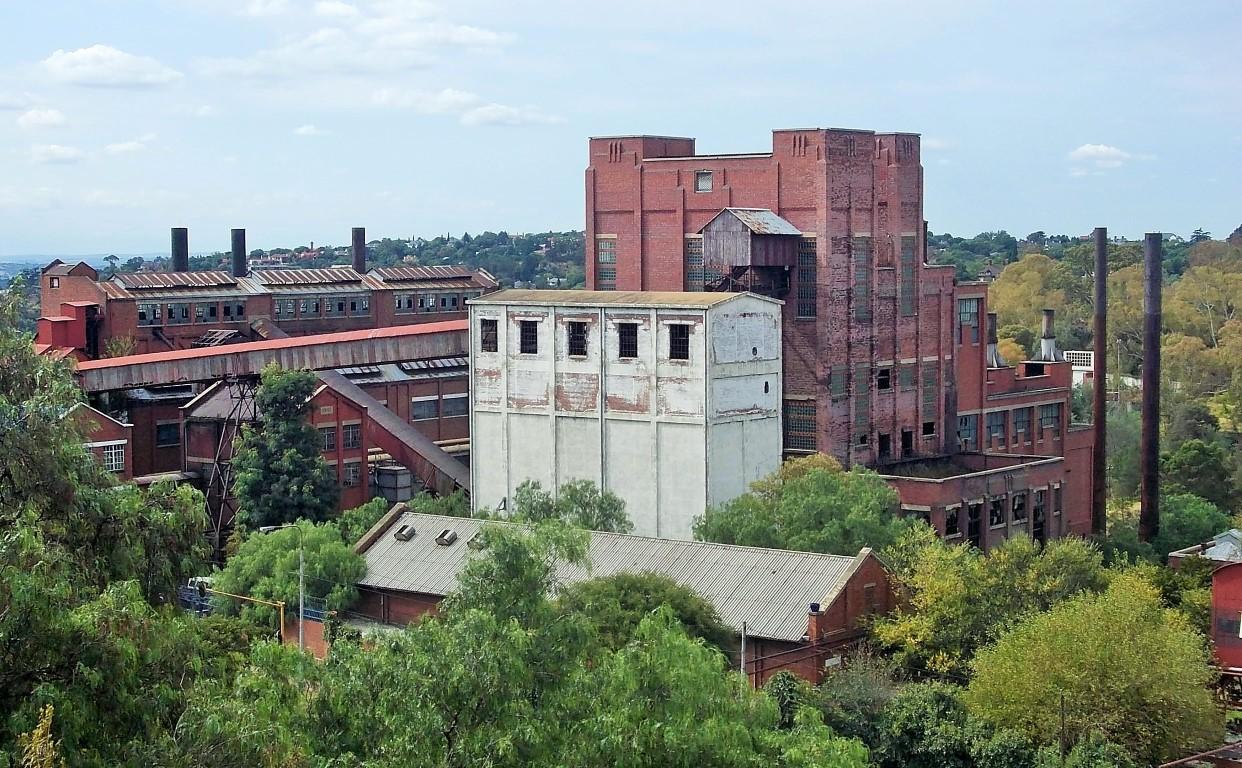
Review of The Johannesburg Gas Works, by Monika Lauferts le Roux and Judith Mavunganidze, published by Fourthwall Books, 2015, 94 pages, illustrated.
I write this review in the context of the pleasure of being a tour leader, on a Johannesburg Heritage Foundation Sunday afternoon excursion through the “Cathedrals of Industry“ of Johannesburg. Dave Gurney and I planned a bus trip from east to west to reveal how industry changed the cityscape. We chose to explore the first of the early corrugated iron workshops of New Doornfontein dating back to the late 19th century, then descended the Ferreira’s Mine stope preserved as a fine deep underground museum in Standard Bank Simmonds Street. Passing Turbine Hall and the preservation of the Jeppe Street Power Station of the 1920s, we drove on to Industria and stopped to marvel at the Art Deco feel and façade of the garden city like Lion Match Company plant dating from 1936. Our final stop and probably the highlight of the afternoon, was at the Johannesburg Gas Works with the opportunity to have heritage consultant Monika Lauferts le Roux and the revered architectural historian Clive Chipkin guiding our eyes to see the wonder of the giant disused brick and iron framed gas plant that dates back to 1928. There were a few dozen people on the tour who were enthused and excited enough to be first in line to savour the new book on Johannesburg Gas Works.
Back of Turbine Hall (The Heritage Portal)
This is a magnificent book and its publication was made possible with the support of Business and Arts South Africa, Egoli Gas and the Graham Foundation of Chicago. The project captured everyone’s imagination. How wonderful that the subject matter of a city’s gas works had appeal enough to attract international sponsorship. The price of the book, which speedily identifies itself as a work of art, comes in at a very inexpensive R435 because it has been subsidised. Of course writing about the gas works of a city is perhaps not the most glamorous topic, but I start my review by waving a flag and applauding fine scholarship and serious industrial archaeology that should make the collector of Johannesburg Africana race to grab a copy. Here is the opportunity to become absorbed by the story of gas, and why this fuel was vital to the domestic comfort and industrial growth of Johannesburg. This is one of those books that matches up to the scholarly work on the city completed by Anna Smith and R F Kennedy in the sixties.
Book cover (Fourthwall Books)
One of the benefits of rethinking old spaces and places in a city such as Johannesburg is that heritage legislation forces new owners and developers to commission a heritage impact assessment to accompany plans for future developments. Possible new uses and incipient revitalization of old industrial plant stimulates an interest in history. The planners and architects scurry to the city archives in search of original plans. The planning of new ventures and the recycling of old land and buildings opens a space for history. History then converts to heritage of the built environment as we probe why the landscape is arranged as it is.
This extraordinary giant industrial plant dating back to the 1920s, is located on a huge expanse of city land. It is an “almost nowhere” sort of space. The site is sandwiched between the edges of the old inner city as it spread towards Braamfontein and the residential suburbs of Auckland Park to the west and Parktown to the north. There are two university campuses close by.
The site from above (The Heritage Portal)
Gas had an earlier history. Its production can be traced back to the first decade of the city when a gas works was established in President Street. In 1927 the City proposed the development of a new gas works on the Cottesloe site. It was a successful venture and the decades of the thirties, forties and fifties were ones of expansion. Decline and stagnation came in the 1960s and 1970s when Sasol began to supplement gas supplies (there is another story here). Finally, in 1988 the decision was taken to close the Gas Works and the production plant finally closed in 1992 and the facilities became a distribution point.
The result of the closure of the Gas Works created an opportunity to reflect on the past and plan a better future. The architects and heritage consultants, Tsica Heritage Consultants, Monika Lauferts le Roux and Judith Mavunganidze have coordinated a team of contributors and produced an unusual book about this industrial icon. The research endeavours of the group have brought forth and preserved an extraordinary array of material on this single enterprise. The book documents the history of the gas works in Johannesburg and reproduces rare archival plans, photographs, diagrams and drawings of industrial plant and processes.
It is a very beautiful book of some 94 pages, exquisitely designed by Oliver Barstow for Fourthwall Books. The slim volume, landscape format with a grey cloth cover (with an inset black and white photo) holds many tipped-in plans and diagrams. It is a book rich in colour photographs plus there are many reproductions of black and white original old photos. The photographs outweigh the text, they are evocative of mood and place. The technical detail is interesting rather than overwhelming. One needs a magnifying glass to make out details on plans and work flow charts. There are plans of structures such as a pump house, a power house or a meter governor and booster house.
Plans presented in the book (Fourthwall Books)
The book itself becomes an archive. It documents and makes accessible a well-known but somewhat mysterious Johannesburg space and industrial plant that local people have always taken for granted. Those giant circular gas tanks, Gasometers, are just part of the familiar landscape as one drives from the Country Club in Auckland Park down towards the Oriental Plaza in Fordsburg, passing Sturrock Park and then the western edge of the Braamfontein Cemetery. The Gas Works sits on the patch of land dividing the more affluent north from the poorer south.
Clive Chipkin has contributed a fine opening chapter on Futurism and the Gas Works which presents the original gas works as a futurist construction that self-consciously proclaimed its modernity. Chipkin contextualises the Gas Works retort house (1928) alongside the Yeoville concrete textures water tower and the Empire Exhibition Tower of Light (that product of the partnership of the Pretoria Portland Cement, the Victoria Falls Power Station and a statement about uncertain futurism, Pearse was the unsung architect). Chipkin explains why the Gas Works was an industrial artefact that used imported British Steel but where later expansion phases used the steel plates manufactured at Vanderbijlpark. He also highlights the high quality local brick and craft construction in the red face brick walling. We do not know who designed the Johannesburg Gas Works, but a tipped in drawing of a general cross section of the Retort house shows the name West’s Gas Improvement Company Ltd, Engineers, Manchester. Here we are reminded that so much of Johannesburg’s industrial machinery and engineering plant was imported from British iron and steel cities such as Manchester and Leeds. Gas, made from coal, was an alternative energy source and used by domestic consumers and by a range of industries. The strength of Chipkin’s chapter lies in his easy fluency with international points of architectural and economic reference. What is the link between our Gas Works and the Battersea Power Station on the Thames or the Gare du Quai d’Orsay in Paris. It is these connections to the edifices of other countries that gives us a new appreciation of this extraordinary industrial edifice that has survived in Johannesburg.
A Cathedral of Industry (Kathy Munro)
Peter Finsen (who died before the book was published) explains in layman’s language the processes of making gas from coal. In a sense the book is a memorial to Peter Finsen who worked as a senior engineer at the gas works for thirty years and it was he who amassed the rich archive of pictures and documents relating to the Gas Works. He was in love with engineering and his photographs give a great sense of place. There is a huge debt owed to Finsen who shared his passion and his collection with the heritage consultants. Many of the photographs are drawn from Finsen’s personal collection. The City of Johannesburg Plans archive has yielded a rich harvest of original plans covering more than four decades. Sally Gaule and David Southwood also contributed some sensitive and revealing contemporary photographs.
Today the Gas Works buildings are dormant and falling into decay and desolation. An aerial photograph of the Gas Works in 2009 shows the three remaining gas tanks and the cluster of plant and buildings being slowly dwarfed by greenery and trees. This is where the reader arrives at the most controversial aspect of the story of the Gas Works. There is a choice of options - demolish and redevelop this vast expanse of land or to conserve, preserve a unique industrial heritage. What do you do when vandals and vagrants strip machinery from the site when the planners talk about “larger conservation plans”. One gathers that the Gas Works was an asset, albeit in decline of the City of Johannesburg, but that in 2001 the peculiar business decision was made to sell the gas works to an American company that then sold 95% of their shareholding to three individuals. How peculiar, yet the authors here fail to delve into the economics of the modern gas business, the essence of black empowerment. At present the major shareholder of Egoli Gas is the Reatile Group. One has no idea of how profitable (or unprofitable) gas production in Johannesburg was or still is. (One of the oddities of life in Johannesburg is that one pays a monthly charge for gas (if you are connected to the system) regardless of use.) I also have grave misgivings about privatization of prime City energy assets when in fact the real value lies in property and landownership of prime real estate.
Aerial shot of the Gas Works (Fourthwall Books)
A final essay by Alexander Opper, attempts to make a case for the future, for the integration of the historic Gas Works site with the adjacent educational and cultural enveloping landscape. He touches lightly on whether past privatization of an industrial site could be rolled back into public ownership, occupation. He tentatively asks whether there is a possible role for private-public partnerships. There are hints at interesting opportunities and possible direction for a future for the gas works as part of a reimagined city landscape of “corridors and carpets”. (Much can be promised and suggested, but unfortunately unless there is some hard economic analysis about real investment options and sources of funding, the Gas Works site remains in limbo. A “Corridor of Freedom” promises development and densification along access and transport routes, and itself creates opportunities for numerous heritage impact studies, but without free enterprise profit driven capital investment or a broadened tax base to substitute public rooted investment plans remain on drawing boards.)
This book is a brilliant and delightful homage to the history of Johannesburg’s Gas Works but I was left with a sense of unease. The excellence of the scholarship moves this book beyond a nostalgia for the past. It is an important study because it documents the past and makes Johannesburg people realize that the city has an industrial heritage that is worthy of preservation. The book is timeous in stirring a wider consciousness of the significance of the Gas Works, but will the book save the Gas Works? My unease remains. Will this book or a heritage impact study become a blue print for a future Heritage complex?
2016 Guide Price: R435.00 from Fourthwall Books (click here for details)
Review copy kindly provided by the authors.
Kathy Munro is an Honorary Associate Professor in the School of Architecture and Planning at the University of the Witwatersrand. She enjoyed a long career as an academic and in management at Wits University. She trained as an economic historian. She is an enthusiastic book person and has built her own somewhat eclectic book collection over 40 years. Her interests cover Africana, Johannesburg history, history, art history, travel, business and banking histories.

